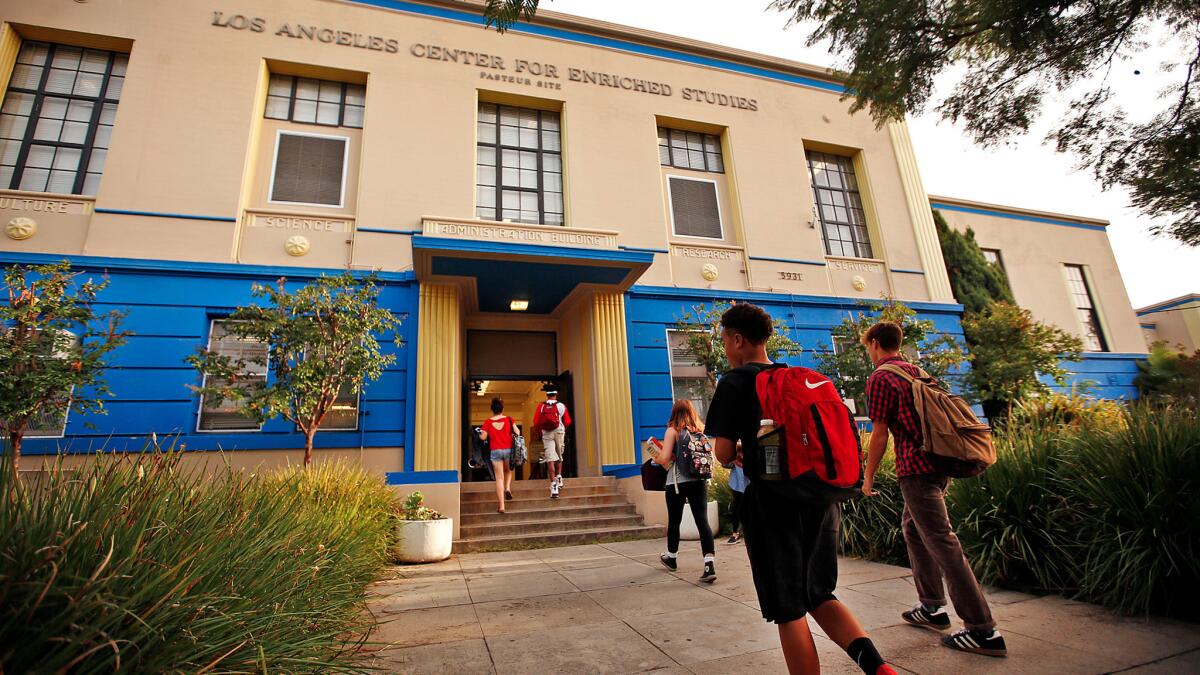Parents who want their kids in L.A.’s most competitive magnet schools face daunting odds

- Share via
Want your child to go to one of L.A.’s most competitive magnet schools next year? You may face daunting odds.
Applications for L.A. Unified’s 225 themed magnets are being accepted through Nov. 10 — and any student potentially can go to any one, regardless of location.
For the record:
1:30 p.m. Oct. 13, 2016In an earlier version of this story, the photo caption incorrectly stated that the Los Angeles Center for Enriched Studies is in Bel-Air. It is in the Mid-City area.
But first there’s the matter of succeeding in the points-based lottery system.
Fewer than half of students who applied to a magnet for the 2016-17 school year were accepted: There were approximately 44,000 applicants, about 21,000 of whom received an initial spot.
And though it wasn’t so hard to get into many of the magnets, and the median magnet school acceptance rate for this school year was 83%, a small number of top schools got a large number of applicants. The most popular magnet accepted just over 3% of those who applied.
Community Magnet Charter Elementary was this year’s most selective magnet school. The K-5 school in Bel-Air accepted 122 students after receiving about 3,700 applications.
Valley Alternative Magnet, a K-12 school in Lake Balboa, was close behind, at first accepting only 93 of about 2,000 applicants.
Those were the initial numbers. Many schools end up dipping deep into their wait-lists, said Keith Abrahams, executive director of student integration services at L.A. Unified. If your child ends up wait-listed at a magnet, you can call the school to find out how far down the list the spot is.
Strangely enough, some schools get a lot of applicants precisely because parents know the odds of getting in are so slim. Students earn four points in the lottery each year they are wait-listed, and can accumulate up to 12 points. So some parents fill out applications to highly competitive magnets early on in hopes to store up points to get their children into top magnets a few years down the road.
It’s risky though. Say you put in an application for your young child at Community Magnet Charter now in hopes of earning points to get her into the Los Angeles Center for Enriched Studies in middle school — and if she gets into Community but doesn’t attend, she’ll lose her accumulated application points.
Children whose neighborhood schools are overcrowded receive four points in the magnet lottery. Applicants with siblings at magnet schools get three points. And any child who finishes at one magnet school — say middle school — and applies to go on to another — say high school — enters the lottery with 12 points.
L.A. Unified magnets as a group perform better on state tests than local charters and other district schools. That might be in part because of their demographics: Magnets have a smaller share of English learners and low-income students than nonmagnets, and a greater share of white and Asian students than the district as a whole. The district created the magnet program as part of a court-ordered desegregation plan in the 1970s.
A few application tips to keep in mind:
Each student can list up to three magnet preferences per year, so picking thoughtfully is key, Abrahams said. The magnets that are in the most demand won’t be right for every child.
“We tell parents you have to see the program,” Abrahams said. “Go with a set of specific questions…. What’s important to you? What do you want in the school?”
- Theme: Each school has a theme: math and science, performing arts, firefighting. The themes are supposed to be reflected to some degree in other classes, so matching your child’s interests is important, Abrahams said.
- Transportation: L.A. Unified provides transportation to magnet schools, but parents are responsible for getting children to bus stops. Because of budgetary constraints, these routes aren’t likely to change, Abrahams said. You can check magnet school bus routes on the L.A. Unified website.
- Academics: Though test scores are just one of many measures of a school, you may want to look up how a particular magnet performs. You can search the L.A. Times database of magnet school test scores .
Even though applications close in November, you won’t find out magnet results until next March.
For more on how to navigate the magnet school applications process, visit our guide to magnet schools, published last year.
Reach Sonali Kohli at Sonali.Kohli@latimes.com or on Twitter @Sonali_Kohli.
To read the story in Spanish, click here
MORE EDUCATION NEWS
How a farm at an L.A. continuation school became a refuge for both students and animals
UPDATES:
10:05 a.m.: This story was updated to include the history of the magnet program.
This article was originally published at 7:48 a.m.
More to Read
Sign up for Essential California
The most important California stories and recommendations in your inbox every morning.
You may occasionally receive promotional content from the Los Angeles Times.













